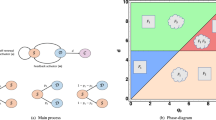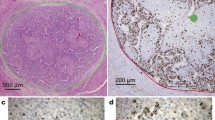Abstract
A stochastic analog to a deterministic model describing subpopulation emergence in heterogeneous tumors is developed. The resulting system is described by the Fokker-Planck or forward Kolmogorov equation. A finite element approach for the numerical solution to this equation is described. Four biological and clinical scenarios are simulated (emergence of heterogeneity, exclusion of a subpopulation, and induction of drug resistance in both pure and heterogeneous tumors). The results of the simulations show that the stochastic model describes the same basic dynamics as its deterministic counterpart via a convective component, but that for each simulation a distribution of tumor sizes and mixes can also be derived from a diffusive component in the model. These distributions yield estimates for subpopulation extinction probabilities. The biological and clinical relevance of these results are discussed.
Similar content being viewed by others
Literature
Becker, E. B., G. F. Carey and J. T. Oden. 1981.Finite Elements—An Introduction, Volume I. New Jersey: Prentice-Hall.
Coldman, A. J., J. H. Goldie and V. Ng. 1985. “The Effects of Cellular Differentiation on the Development of Permanent Drug Resistance.”Math. Biosci. 74, 177–198.
Day, R. S. 1986. “A Branching Process Model for Heterogeneous Cell Populations.”Math. Biosci. 78, 73–90.
De, S. S. 1984. “Random Predator-Prey Interactions in a Varying Environment Colon Extinction or Survival.”Bull. math. Biol. 46, 175–184.
Dexter, D. L., E. N. Spremulli, Z. Fligiel, J. A. Barbosa, R. Vogel, A. Van Voorhees and P. Calabresi. 1988. “Heterogeneity of Cancer Cells from a Single Human Carcinoma.”Am. J. Med. 71, 949–956.
Fleming, W. H. and R. W. Rishel. 1975.Deterministic and Stochastic Optimal Control. New York: Springer.
Glowinski, R. 1984.Numerical Methods for Nonlinear Variational Problems New York: Springer.
Goldie, J. H. and A. J. Coldman. 1979. “A Mathematical Model for Relating the Drug Sensitivity of Tumors to their Spontaneous Mutation Rate.”Cancer Treat. Rep. 63, 1727–1733.
Gresho, P. M. and R. L. Lee. 1979. “Don't Suppress the Wiggles—They're Telling You Something!”Finite Elements Methods for Convection Dominated Flows, T. J. R. Hughes (ed.), pp. 37–61. New York: American Society for Mechanical Engineering.
Harrison, G. W. 1988. Numerical Solution of the Fokker-Planck Equation Using Moving Finite Elements.”Numer. Methods Partial Differential Equations 4, 219–232.
Inagaki, H. 1982. “Selection under Random Mutations in Stochastic Eigen Model.”Bull. math. Biol. 44, 17–28.
Jansson, B. and I. Revesz. 1974. “Analysis of the Growth of Tumor Cell Populations.”Math. Biosci. 19, 131–154.
Leith, J. T., S. Michelson, L. E. Faulkner and S. Bliven. 1987. “Growth Properties of Artificial Heterogeneous Human: Tumors.”Cancer Res. 47, 1045–1051.
—, L. E. Faulkner, S. F. Bliven and S. Michelson. 1988a. “Compositional Stability of Artificial Heterogeneous Tumors in vivo: use of Mitomycin C as a Cytotoxic Probe.”Cancer Res. 48, 2669–2673.
—, L. E. Faulkner, S. F. Bliven and S. Michelson. 1988b. “Tumor Bed Expression in Xenografted Artificial Heterogeneous Colon Tumors”Int. J. Radiat. Oncol. Biol. Phys. 15, 151–158.
Michelson, S., B. E. Miller, A. S. Glicksman and J. T. Leith. 1987.Tumor Micro-Ecology and Competitive Interactions.J. theor. Biol. 128, 233–246.
— and J. T. Leith. 1988a. “Effects of Differential Cell Kill on the Dynamic Composition of Heterogeneous Tumors.”J. theor. Biol.,128, 233–246. in press.
—, and —. 1988b. “Introduction of Subpopulation Exclusion within Heterogeneous Tumors by Environmental Stress.”Radiat. Res. 115, 533–542.
Mortensen, R. E. 1969. “Mathematical Problems of Modeling Stochastic Nonlinear Dynamic Systems.”J. Stat. Phys. 1, 271–296.
Peaceman, D. H. and H. H. Rachford. 1955. “The Numerical Solution of Parabolic and Elliptic Differential Equations.J. Soc. ind. appl. Math. 3, 28–41.
Turelli, M. 1977. “Random Environments and Stochastic Calculus.”Theor. Popul. Biol. 12, 140–178.
Author information
Authors and Affiliations
Additional information
Research support provided in part by ACS Grant IN45-Z and ACS PDT 243 B.
Research support provided in part by the National Science Foundation under NSF Grant MCS-8504316, and by the Air Force Office of Scientific Research under Contract F49620-86-C-0111.
Rights and permissions
About this article
Cite this article
Michelson, S., Ito, K., Tran, H.T. et al. Stochastic models for subpopulation emergence in heterogeneous tumors. Bltn Mathcal Biology 51, 731–747 (1989). https://doi.org/10.1007/BF02459658
Received:
Issue Date:
DOI: https://doi.org/10.1007/BF02459658




